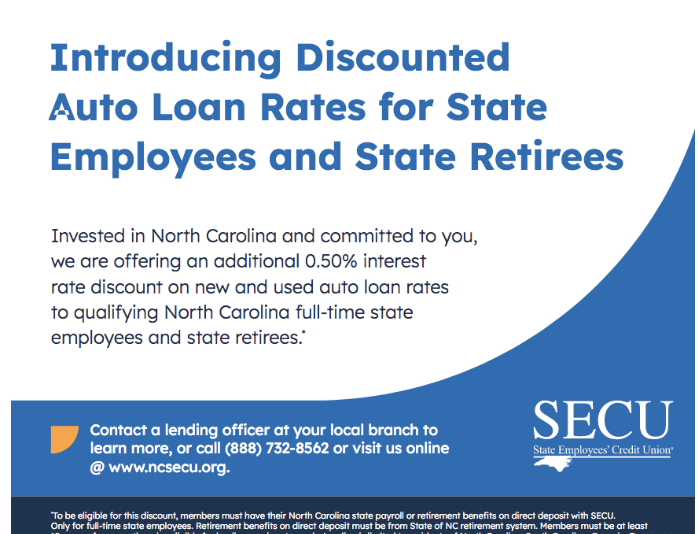(Case study 3 of 3 on cooperative democracy)
What could be the most significant board election in the history of the credit union system is now underway.
State Employees Credit Union (SECU) North Carolina is in the middle of a two month qualification and member voting period for three open seats on its eleven person board. There are six candidates on the ballot. Three were board nominated-all sitting directors. Three are the result of their garnering a minimum of 500 member signatures supporting their candidacy.
Absentee voting began September 1 and in-person voting ends with the Annual Meeting on October 10, 2023.
SECU’s website contains documents describing the Annual meeting, critical dates and voting steps. The current board members are listed. There is a “Statement of Background” on each of the six candidates.
There is no other election information I could find on the website, such as statements from the candidates about why members should support them.
This Vote’s Impact the Credit Union System
SECU is huge. At June 30 it reported $49.6 billion in total assets, almost 8,000 employees serving 2.8 million members in 275 branches.
The first lesson from this vote is that one of the largest credit unions with members distributed throughout the state can successfully conduct a contested election for open board seats. Most large credit unions’ annual director “elections” are via “acclamation.” The number of candidates equals the open seats, so no ballot.
SECU shows the feasibility of both an absentee ballot and in-person voting culminating in the Annual Meeting.
Secondly member-owner voting matters. The outcome of this ballot will confirm or potentially reset the credit union’s business priorities with members. Given the circumstances preceding this vote, the members’ choice will make a difference. This is the owners’ role, but one rarely consulted.
How This Contest Developed
At the October 2022 Annual Meeting former CEO Jim Blaine read a statement asking how six “initiatives” were in the members’ best interests. These included a potential merger, FOM expansion, risk based pricing and other service changes. The two resolutions were deeply informed and adopted without opposition.
Jim had been completely absent from the credit union for over 6 years. His role at the 2022 Annual Meeting was in response to concerns that many current members and senior staff of both SECU and LGFCU had asked be raised on their behalf.
These employees and members were deeply apprehensive in the about face of SECU policies and practices. Few however were in a position to knowledgeably question the changes.
Blaine and prior board’s leadership was based on a different cooperative vision of SECU than the new CEO, Jim Hayes and his team, were implementing. Their business priority is to modify SECU’s efforts to more closely mirror how other large credit unions were growing.
The cooperative model that Blaine and his successor Mike Lord had implemented was based on “a democracy of opportunity.” Every member received the same rate for the same loan type and the same return on savings regardless of balances.
The focus was on serving those who might have the least, or know the least, but have traditionally been charged the most for financial services at other firms.
These two CEO’s had invested decades creating a culture with SECU branches in every county, on-site decision making and execution, all informed by local advisory boards. There was no upselling or employee bonuses. Promotion from within was preferred. Advertising was word of mouth or press releases about SECU’s foundation grants.
To many an outsider and professional peers, this approach seemed “old school’, out of touch with current options and overlooking major markets of opportunity.
After waiting for a productive dialogue and response with the leadership, in February 2023 Jim launched a blog SECU-Just Asking ! to take the issues public. The new CEO Hayes left in June and the board appointed 35-year SECU employee Leigh Brady as CEO.
Risk based pricing on consumer loan products continued. Blaine’s blog became a center for critical commentary. It is now engaged in the board election to support the three “outsider” candidates.
This contested election will give the member-owners the chance to express their views on the credit union’s direction-that is the one member, one vote coop design.
The Campaign Underway
The evidence of public campaigning for member support is limited. SECU is putting its best food forward offering rate specials:
The web site has short videos of Who We Are with emphasis on SECU’s North Carolina roots. There are brief statements by board members on LinkedIn and reports of CEO Brady and board member visits to branches.
Blaine continues his daily analysis of current leadership and trends on Just Asking!. For example he calls out the fact that over the past 12 months members have withdrawn over $4 billion in savings. He urges support for the three member nominated candidates and contrasts their views with the incumbent directors’ recent decisions.
I sent an email to all six candidates. It stated I was writing a blog on coop democratic governance and wanted to present their efforts as candidates.
I suggested three questions: How are you campaigning? What is the value of an election for members? Your top priorities if elected?
Two candidates responded, both member-nominated. Excerpts of their replies are below. I believe that their words convey the issues more clearly than any professionally produced campaign statements or videos.
Michael Clements whose qualifications are on the website sent the following:
How Campaigning: I have asked for support from our local advisory board (I am a member). . . asked them to share my information with their individual networks for support. . . I am not on social media (but a member of several other boards) so for my friends and colleagues I have asked them to share with their social media contacts.
Value of an election: The value of any election is to bring in new people who may provide new ideas and alternate ways of doing business. Historically, we were given the opportunity at the annual meeting to get nominations from the floor which, to me, represented an openness to potentially obtaining and recruiting new board members and maybe new energy and ideas.
The present practice of the nominating committee to interview those members who want to serve and then rejecting them for the status quo seems disingenuous. Then to ask that if you want to self-nominate that you will need to obtain 500 actual signatures in 10 days! appears as an attempt to discourage rather than encourage an openness to be inclusive for our members. I have served on four boards/committee with SECU.
Top priorities: I could work to strengthen the foundation that has allowed SECU to become an incredible organization and the second largest credit union in the US. MEMBERS FIRST! When you look at our logo, State Employees Credit Union, it has the image of North Carolina and then states “There is a difference!”
This difference is that in our credit union, every member is equal and can avail themselves of all of the services which they qualify for. No member is better than another and will thereby receive preferential treatment. This difference is that we will NOT treat our members as if we are a traditional bank. . .
The second replyis from Barbara Perkins whose background is on the website.
How campaigning: I feel it is important to mention that the first members to whom I appealed were those serving on the Board of Directors. . . After striking out, I started creating awareness through my personal Facebook page and emails to family, friends, former coworkers, former NC SECU employees, Loan Review Committee volunteers (25+ years of service), and Advisory Board volunteers (8 years of service). . . Once I qualified to run for the board, many of my friends/family/coworkers volunteered to help me obtain the required 500 signatures in the given 10 days. . . currently I have a post on my FB page leading them to the www.SECUjustasking.com blog so my FB friends and their friends can research the history of the current board, the changes to policies and examples of judgments that have been detrimental, in many people’s opinions, to the NC SECU.
Value of an election: We have had ‘contested elections’ in the past. Any member could do what was truly a ‘self-nomination’. They expressed their desire to run, their biography (which they were allowed to write) was distributed at the annual meeting, they were allowed to speak to the membership before the voting and we voted. If you review the (new) ‘rules of behavior’ for the Annual Meeting, this has changed. . . ‘contested elections’ inspire transparency and communication which should be provided voluntarily by the board. Public relations firms can provide fancy words but actions are the proof of intention.
Top Priorities: Each topic included 3-5 specific actions, omitted for brevity.
- a) Return unity of purpose to the membership, the employees and the management by getting back to the basics
- b) Prioritize member needs with Credit Union operating funds (
- c) Return to programs that benefit the membership
- d) Stay in our lane
The three member candidates were also profiled on Just Asking!
Member Commentary
Beyond the SECU website I could not find any other organized public coverage of the campaign. Some members following events are posting on the Just Asking! blog. An example of their involvement are the 42 comments after the September 11, 2023 post which profiles an incumbent candidate, Garland, who would become the new Chair if elected. Two of the many remarks:
Most people live in darkness with no clue what’s going on around them.. You don’t need to have 10 degrees to know that SECU losing 4 billion dollars under this leadership is not a good thing. or,
Let’s have the nerve to tell the members about this. They can see what is happening in the drop in quality, bad rates. We need to tell them who is doing it to them.
SECU’s Example
In many credit union CEO’s view, the cooperative model developed by Blaine/Lord is seen as an anachronism, behind the times. The fact that it had become the second largest credit union in the country by far, and had recorded 85 years of steady growth was discounted as an anomaly to current strategic thinking. SECU’s many innovations in both product and service strategies and the employee culture were largely overlooked.
However the most important result of this coop’s model is not financial asset size or stability. It is that members believe in and support their credit union. That trust has been and still is the foundation to sustained success for every firm.
Democratic voting is the water that keeps a cooperative’s grass roots healthy. In this case it may be the means to bring it back to life.
Members have become engaged as owners. They are using their voting to assert their views about the future direction of SECU. This is what democratic governance offers.
This example is an event that could bring new life to other large credit unions, now groping with technology fixes, merger solicitations and even bank purchases to maintain their market relevance.
SECU shows the business process is much simpler. Just give members a voice and keep in touch with their priorities. Members will transform into owners willing to invest more than their money, but even more critically, their energy and commitment when their credit union’s future is at stake. Those are the fans whose loyalty any leadership team should crave.


